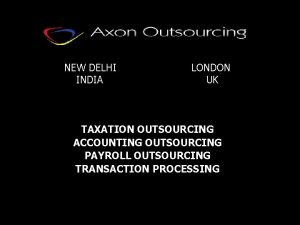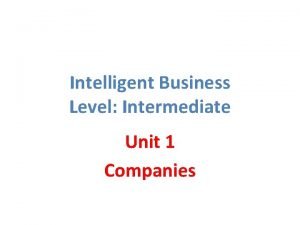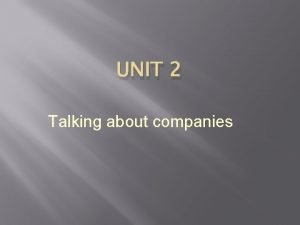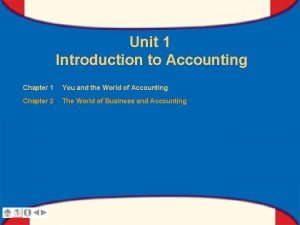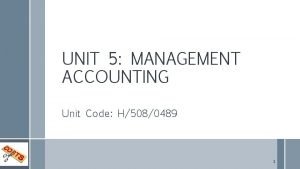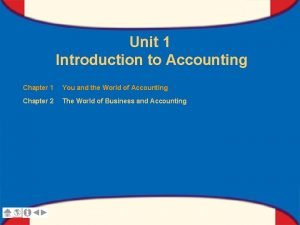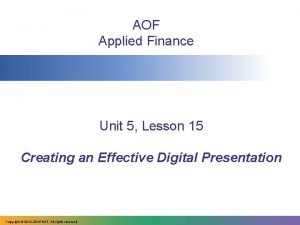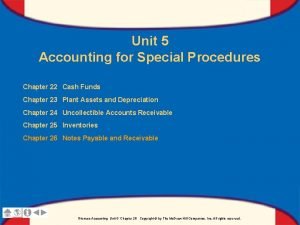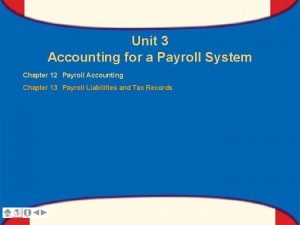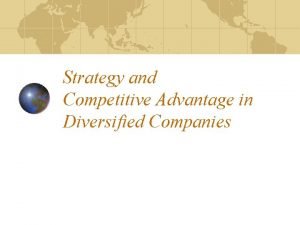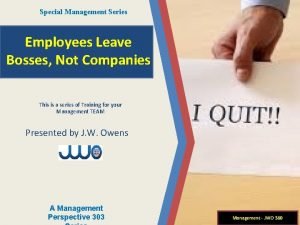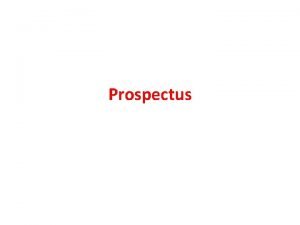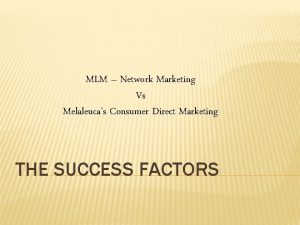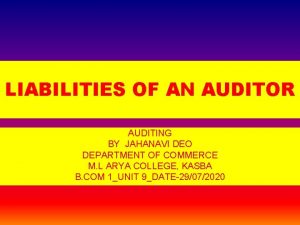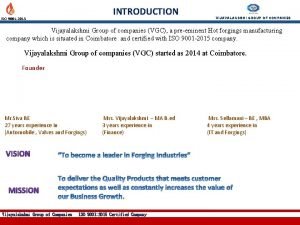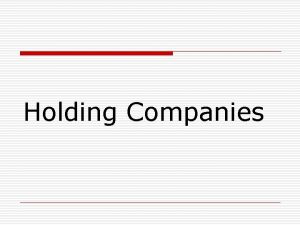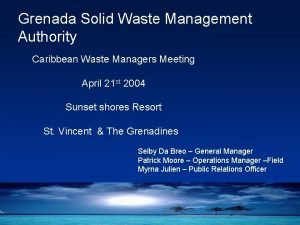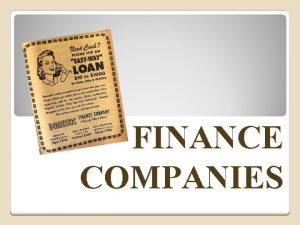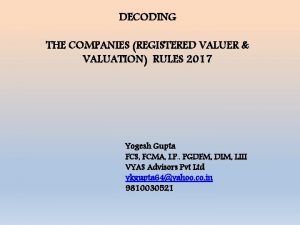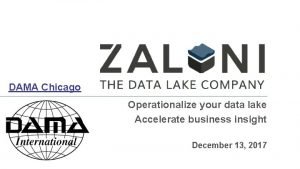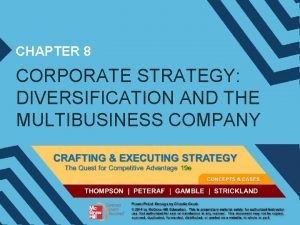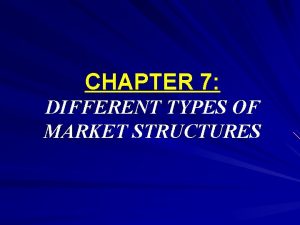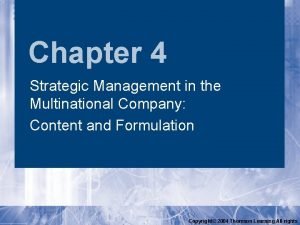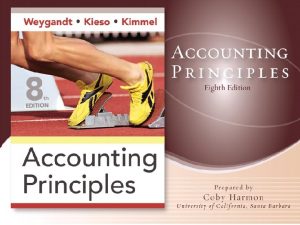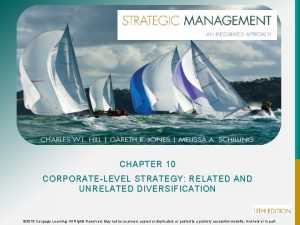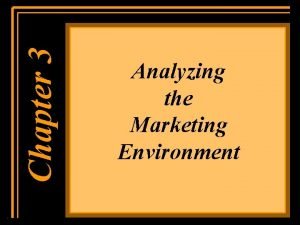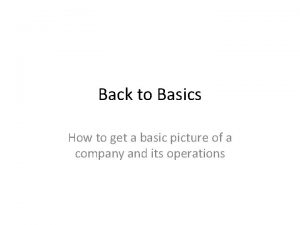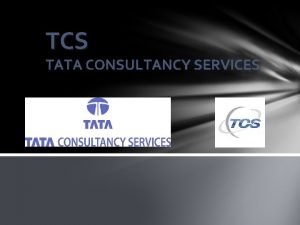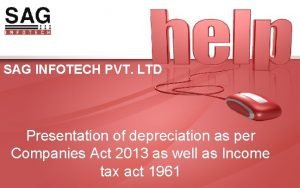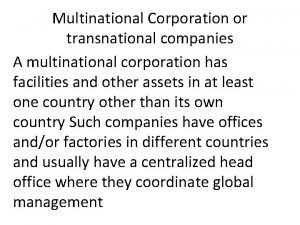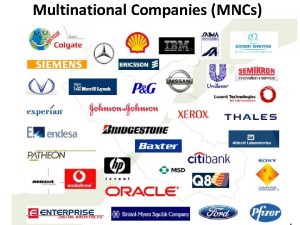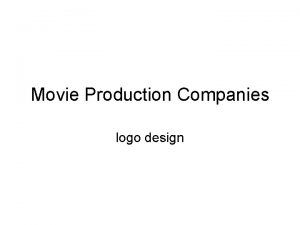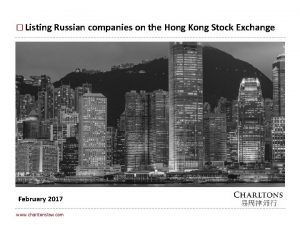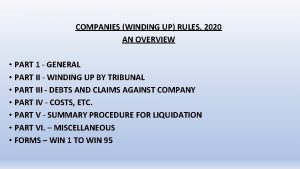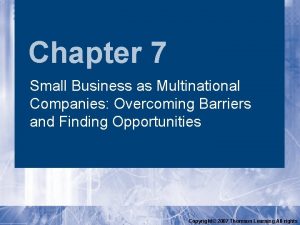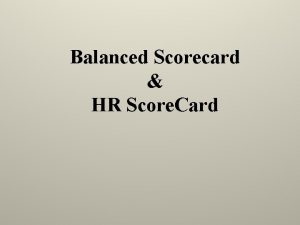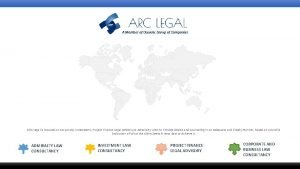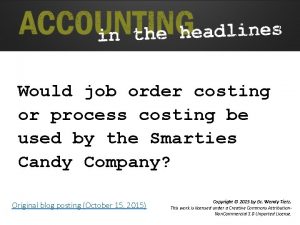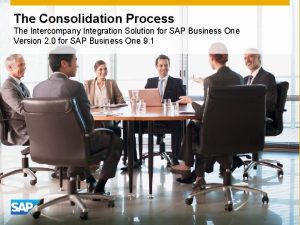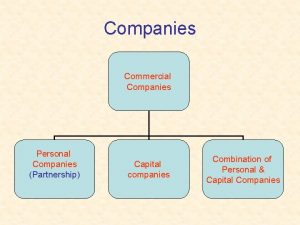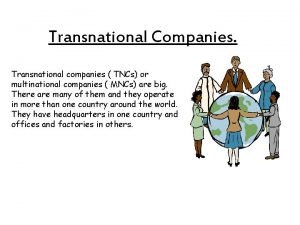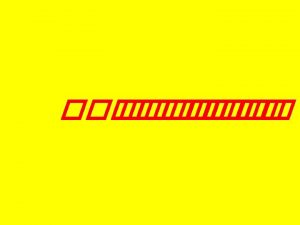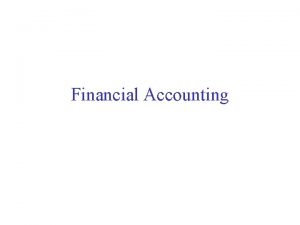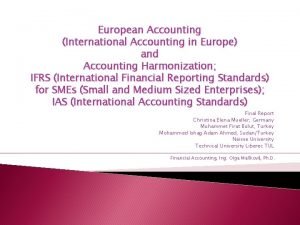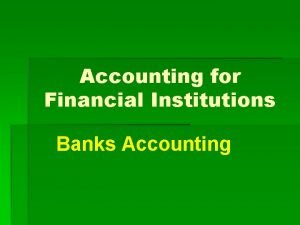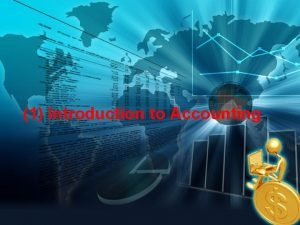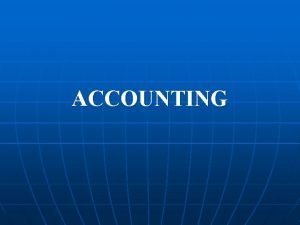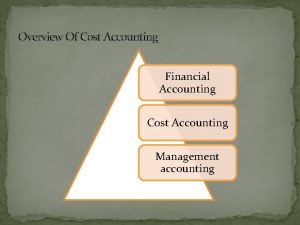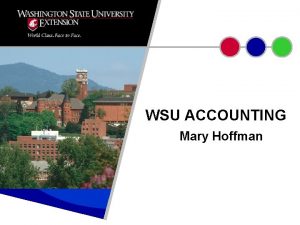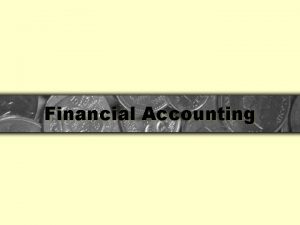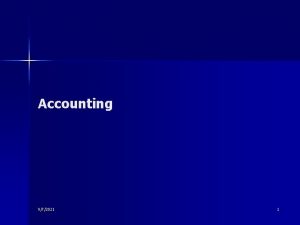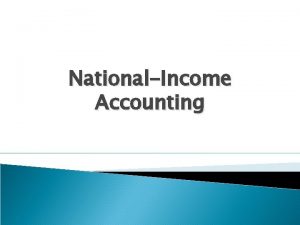ACCOUNTING UNIT 4 Kramed Unit 4 COMPANIES Companies






































































- Slides: 70

ACCOUNTING UNIT 4 Kram’ed

Unit 4

COMPANIES

Companies • A Company is an incorporated body registered under the Corporations Act 2001. They embody the following characteristics: • Limited Liability • Number of Owners (depending on type) • Number of Directors (depending on type) • Continuity of Existence • Seperate Legal Entity • Transfer of Ownership • Seperation of Ownership and Management

Public Company • ‘Limited or ‘Ltd’ in its name • Owner’s equity limited by the shareholders • Minimum 1 Shareholder (no maximum) • Shares and Debentures can be issued to the general public • Minimum 3 Directors (2 being residents of AU) • AGM must be held within 5 months of the end of the financial year: Directors and Shareholders meet an discuss matters such as dividends, bonus share issues and election of board members • Maintain and publish annual financial reports (complying wit AASB) and publish them to shareholders and ASIC on an annual basis • Can seek public and capital contribution by being listed on the ASX

Proprietary Company… • ‘Proprietary’ or ‘Pty’ in its name • Cannot raise funds from the general public • Between 1 and 50 shareholders • Minimum 1 shareholder and optional secretary (both residents of AU) • Classified into ‘Large’ and ‘Small’

Large/Small Proprietary Company… • Corporations Act 2001 identifies a ‘Large Proprietary Company’ if it meets 2/3 criteria: 1) Gross Revenue > 25 Million 2) Gross Assets > 12. 5 million 3) Fulltime Employees > 50 • Large Proprietary companies must produce financial reports annually, lodge them with ASIC and publish them to shareholders • Small Proprietary Companies only need to publish annual financial reports if requested by ASIC or by shareholders with excess of 5% ownership

Company Startup • Submit the following information together with a prescribed fee to ASIC. • • • キ Name of the Company キ Names of Initial Shareholders キ The company’s registered office キ The principal place of business キ A copy of the Company’s Constitution and any amendments made to the replaceable rules. For a Public Company a prospectus is issued to the general public, inviting them to purchase shares or debentures. A prospectus must contain all the information that a potential investor would require in order to make an informed decision. It also should contain an application form so those subscribing can enter into contract after being informed by the document.

Replaceable Rules • The rules for management of a company can either be governed by the Replaceable Rules of the Corporations Act 2001 or by an optional Company Constitution drawn up and agreed upon by the directors and shareholders. The Replaceable Rules concern: • The powers of directors and how they are appointed • How voting procedures are conducted at meetings of shareholders • The procedure for calling and running director’s meetings • How many votes are allocated to each shareholder • Terms and conditions of office of a company secretary • The different transfers, dividend rights and classes of shares

The Company Ledger Ordinary Share Issue is subscribed: Example - 2 nd of Feb Company issues prospectus offering 80 000 ordinary shares at issue price of $2 (payable in full on application) - 21 st of Feb shares were fully subscribed DATE 21/2 Cash at Bank Applications Shares subscribed DR 160 000 CR 160 000

The Company Ledger Shares are allotted: Example - 23 rd of Feb Shares are allotted DATE 23/2 Applications Share Capital Shares Allotted DR 160 000 CR 160 000

The Company Ledger Issue costs are paid: Example - 24 th of Feb Share Issue costs of $700 are paid (printing of prospectus etc) - These are written of against share capital. DATE DR 24/2 Share Issue Costs 700 Cash At Bank Payment of share issue costs 24/2 Share Capital 700 Share Issue Costs Transfer of share issue costs CR 700

The Company Ledger Bonus Share Issue: Example - 28 th of Directors decide to make a 1 for 5 bonus share issue out of the General Reserve (80 000 shares at $2 ea = 160 000 share capital) - 160 000 / 5 = 32 000 DATE 28/2 General Reserve Share Capital Bonus share issue made DR 32 000 CR 32 000 Note: Bonus Share Issues to not increase the overall equity of a company as there is no additional capital contribution

The Company Ledger Interim Dividend declared and paid: Example - 3 rd March Directors declare 5 cents per share dividend be paid to Ordinary Shareholders, this was paid on 20 th of March DATE 3/3 Retained Earnings Dividend Payable Dividend Declaration DR 8 000 20/3 Dividend Payable Cash At Bank Dividend Paid 8 000 CR 8 000 • Note: Sometimes Dividends are made out of other reserves, however if not specified assume ‘Retained Earnings, ’ Regular Dividend Payments are entered the same. 8 000

The Company Ledger Transfer to Reserves: Example - $5000 is transferred from Retained Earnings to General Reserve on the 4 th of July DATE 4/7 Retained Earnings General Reserve Transfer to Reserve DR 5 000 CR 5 000

The Company Ledger Asset Revaluation: Example - Property was revalued up by $100 000 on the 9 th of July DATE 4/7 Property, Plant & Equip Asset Revaluation Rsv. Asset Revalued DR 100 000 CR 100 000

External Audit • Public / Large proprietary Companies are required by ASIC to be externally audited. • External Auditors must be registered with ASIC and are called RCA (Registered Company Auditors. ) • They must comply with Corporations Act 2001 and the auditing standards as specified by the Auditing and Assurances Standards Board. • Auditors must produce a report depicting the accuracy and reliability of financial reports, inclusive of a qualitative statement • Identified issues will be pointed out to management, if not addressed they will be considered in a qualified report • If independent requirements are met the report is signed off and sent to shareholders

Rights of the Shareholder • Public Company: 1) Should the Company deregister shareholders are entitled to the repayment of their capital after all creditors have been paid 2) The right to vote at annual meetings of shareholders to elect the directors of the company 3) The right to receive annual financial reports of the company Transfer of ownership: • Public Company shareholders may sell shares at will without any restriction • Replaceable Rules may prevent a Propriety Company shareholder from selling shares without the approval of other shareholders

Duties of Directors • Carry out duties with reasonable level of skill and car • Act in the best interest of shareholders • Declare any conflict of interest • Ability to hire or fire senior managers • Approval of share issues and loans

Role of the Conceptual Framework • Australian Accounting Standards Board (AASB) • The AASB is an Australian Government agency under the Australian Securities and Investments Commission Act 2001. • AASB Accounting standards are put in place in order to maintain high-quality financial reporting standards for all sections of the economy. They are a set of rules and regulations that reporting entities must follow.

Reporting Entities • • Reporting Entities are those reasonably expected to have users who depend on the entity’s general purpose financial reports for information that will be useful for them for making and evaluating decisions about the allocation of scarce resources. AASB 101 (paragraph 10) requires public companies and other reporting entities to produce a number of financial reports, accessible to the general public. These include: 1) Statement of financial position at the end of the period 2) Statement of comprehensive income for the period 3) Statement of changes in equity for the period 4) Statement of cash flows for the period 5) Notes comprising a summary of accounts and other necessary explanations

Accounting Standards cont. • The main purposes of Accounting Standards is to provide protection to the external users of reports, facilitate Australian capital markets and assist managers and directors to discharge their duties. • The Conceptual Framework of Accounting is a body of AASB theory that includes Statement of Accounting Concepts (SAC) • SAC 1 defines and identifies a reporting entity with a number of qualities including: The segregation of management and owners, economic and political importance and financial significance. • Upon fulfilling these characteristics Reporting Entities shall produce general purpose financial reports, in a manner that assists in discharging their accountability (SAC 2, paragraph 43. ) • General purpose financial reports shall disclose information relevant to the assessment of performance, financial position and financing and investing including information about compliance (. SAC 2, paragraph 44)

COMPANY FINANCIAL REPORTS: CASH FLOWS

The Cash Flow Statement • This statement is not based on Accrual Accounting, instead it recognises transactions as cash changes hands. • This gives an indication of the liquidity of the business and its ability to turn over cash in the given time period.

STATEMENT OF CASH FLOWS FOR PERIOD ENDING Cash Flows from Operating Activities Cash Receipts from Customers Cash Receipts from fees, royalties and commissions Cash Paid to Suppliers and Employees Cash Generated from Operations Interest Paid Income Tax paid Net Cash Flows from Investing Activities Purchase of Investment Purchases of Property, Plant & Equipment Proceeds from sales of Investments or Property, Plant & Equipment Interest Received Dividends Received Net Cash Flows from Financing Activities Proceeds from issue of Share Capital Proceeds from long-term borrowings Dividends Paid Net Cash Net (Increase/Decrease) in cash / cash equivalents during period Cash / cash equivalents at beginning of the period Cash / cash equivalents at end of the period X X (X) (X) X (Y) Y Y Y (Y) Z Z (Z) XYZ A AXYZ

Reconstructions • Before completing this statement, cash flows must be derived from accrual reports of the Balance Sheet and Income Statement. • Just because and expense or revenue was incurred it does not mean actual cash was exchanged on the same date. • There fore 5 sets of account reconstructions must be done. 1) Accounts Receivable 2) Accounts Payable 3) Pre-Paid and Accrued 4) Retained Earnings 5) Sale of Asset Other cash flows are simply derived from observing the increases / decreases in account balances

Reconstructions Precursor • - All figures that are taken from the: Balance Sheet will be Blue Income Statement will be Green Cash figures will be in Red Example figures will be used from the following financial reports:

Income statement For Bali Hai Traders 2009 2010 Sales (Credit) 95 000 105 240 Sales (Cash) 10 000 12 000 Less Sales Returns 350 259 Less Cost of Sales 5 000 4 406 Gross Profit 99 650 112 575 - 130 Rent Revenue 240 250 Discount Received 230 210 Interest Revenue 210 310 - 1728 100 330 115 203 Add Other Revenue Dividends Proceeds on sale of Motor Vehicle Total Income

Income Statement cont. Less Expenses Carrying amount on sale - 900 Electricity 600 518 Advertising 1020 985 Discount Allowed 65 52 Telephone and Fax 240 130 - 1 044 6 000 5 832 240 130 Depreciation on plant 1 050 907 Total expenses 9 215 10 498 Net Profit (before tax) 91 115 104 705 Bad Debts Wages Depreciation on buildings

Balance Sheet EXTRACT For Bali Hai Traders 2009 2010 1 296 ? 518 130 Debtors 1 200 1 500 Inventory 2 808 3 110 65 110 Shares in other Companies 1 037 1 296 Property Plant & Equipment 14 904 15 336 Motor Vehicle 21 600 25 920 Less Accum. Depreciation 4 500 5 000 ASSETS Cash & Cash equivalents Accrued Interest Prepaid Advertising

Balance Sheet EXTRACT For Bali Hai Traders 2009 2010 Creditors 648 1 512 Accrued Wages 389 130 Loan from Bank 7 646 30 000 Unearned Rent 518 648 Income Tax Paid 389 259 Share Capital 8 683 11 232 Retained Earnings 2 592 3 024 LIABILITIES EQUITY

Additional Information • Shares in other companies and property, plant and equipment were purchased during the year ended 30 June 2010 using cash • All purchases were made on credit, purchase returns of $130 • An ordinary share issue was made. Application closed fully subscribed • A motor vehicle that had an accumulated depreciation totaling $4320 was sold for $1728 cash. It had a carrying amount of $900. Any new motor vehicles purchased during the year were for cash • Cash dividends were paid during the year • $5000 was transferred from the retained Earnings account to the general Reserve

Recon: Accounts Receivable 1. 2. 3. 4. Insert Balance for beginning and end of period from balance sheet Insert Credit Sales on Debit side Insert reduce effect figures on credit side e. g bad debts, sales returns Find missing cash figure for cash received from debtors, by subtracting DR and CR sides Accounts Receivable Bal 1200 Credit sales 105 240 Discount Allowed 52 Bad Debts 1044 Purchase Returns 259 CASH 103 585 Bal 1200 This figure will be part of ‘Cash receipts from Customers’ Which will also include ‘Cash Sales’ ( no recon needed)

Recon: Accounts Payable 1. 2. 3. 4. 5. Insert Balance for beginning and end of period from balance sheet for both ‘Inventory’ and ‘Accounts payable’ Insert Cost of Sales (COS) on Credit side of ‘Inventory’ Find missing figure in ‘Inventory’ and insert in ‘Accounts payable’ Insert reduce effect figures on debit side of ‘Accounts Payable’ e. g discount received Find missing cash figure for cash paid to creditors, by subtracting DR and CR side Accounts Payable Disc. Rec. 210 Returns 130 CASH 3 504 Bal 1 512 Bal Inv. 648 4 708 Inventory Bal 2808 Acc. Pay. 4708 COS 4406 Bal 3110 This figure will be part of ‘Cash paid to suppliers and employees

Recon: Prepaid 1. 2. Insert Balance for beginning and end of period from balance sheet Insert Expense on credit side 3. Find missing cash figure for cash paid to advertising, by subtracting DR and CR sides Prepaid Advertising Bal 65 Adv. Expense CASH 985 1 030 Bal 110 This figure will be part of ‘Cash receipts paid to Suppliers & employees

Recon: Accrued 1. 2. Insert Balance for beginning and end of period from balance sheet Insert Expense on credit side 3. Find missing cash figure for cash paid to advertising, by subtracting DR and CR sides Accrued Wages Bal Wage Expense CASH Bal 389 5 832 6 091 130 This figure will be part of ‘Cash receipts paid to Suppliers & employees

1. 2. 3. 4. Recon: Sale of Asset Insert Balance for beginning and end of period from balance sheet for ‘Motor Vehicle, ’ ‘Accumulated Depreciation’ and ‘Gain on Sale of Motor Vehicle’ Credit ‘Motor Vehicle’ at cost to show removal of asset from hands of business, Debit ‘Sale. ’ Missing figure is Vehicles purchased Debit ‘Accumulated Depreciation’ for depreciation accumulated on sold asset, Credit ‘Sale, the missing figure is Depreciation Expense Find missing cash figure for cash received from sale of motor vehicle, by subtracting DR and CR side Motor Vehicle Bal CASH 21 600 4320 Bal 5000 Bal Dep Exp. 5220 9 540 Bal 25 920 Gain on Sale of Motor Vehicle Accumulated Depreciation Sale Motor 5220 Accum. 4320 Dep. 4500 Vehicle 4820 CASH 1 728 These figures will be part of ‘Investing Activities’ Bal 828

Cash Flow Statement • Figures used from the reconstructions and account figure differences are then used to formulate the aforementioned report • The Net Cash flows from Operating, Investing and Financing activities should equal the net increase or decrease in cash / cash equivalent holdings during the year.

Analyzing the Cash Flow Statement • The statement of cash flows is a vital document that depicts liquidity. It answers the following questions: - How was the purchase of non-current assets financed? - How did the business use its cash flows from operating activities? - How did the company pay a dividend if it made a loss? - Was the company able to repay the debt?

Analyzing the Cash Flow Statement • Step 1 : State and detail the overall change in cash holdings and whether this is beneficial for the business (negative cash holdings could be beneficial for expansion) • Step 2/3 : State and examine reasons for the net cash flow in each operating, investing and financing activities and whether they are beneficial for the business. • Step 4 : Draw a final conclusion to whether the company’s cash position has improved or not.

COMPANY FINANCIAL REPORTS

Statement of Comprehensive Income • This is a financial statement that details the total comprehensive income of a company for a given period representing the change in equity over that period, other than changes resulting from transactions with owners in their capacity as owners. • AASB 101 does not prescribe a particular format, however require all recognized income and expense for the period, including income tax payable. A widely accepted format is given on the next slide.

Statement of Comprehensive Income. For year ended Notes Revenue Cost of Sales Gross Profit Other Income 1 Expenses (excluding financial) 2 Finance Costs Profit before income tax Income Tax Expense PROFIT FOR THE PERIOD Other Comprehensive Income Gain on Asset Revaluation Foreign Exchange Differences Gain/Loss for sale of financial assets Income tax on other comp. income Other Comprehensive Income for period TOTAL COMPREHENSIVE INCOME FOR THE PERIOD 2010 2011

Statement of Comprehensive Income. For year ended NOTES 1. Other Income Gain on sale of asset X Discount received X XX 2. Expenses Selling and Distribution X General and Administration X XX

Statement of Financial Position • This is a classified statement that details the assets, liabilities and equity of a financial entity at a point in time. The statement contains information that is summarised for ease of understanding, additional details being included in notes.

Statement of Financial Position. As at Notes ASSETS Non-current Assets Property, Plant & Equipment 1 Current Assets Total Assets EQUITY AND LIABILITIES Equity Share Capital 2 Retained Earnings Other Components of Equity Total Equity Non-current Liabilities Current Liabilities Total Equity and Liabilities 3 2010

Statement of Financial Position. As at NOTES 1. Property Plant & Equipment Property X Plant X Equipment X XXX 2. Share Capital 2 million ordinary shares issued at $1. 50 ea 3 000 1 million preference shares issued at $1. 00 ea 1 000 4 000 3. Other Components of Equity General Reserve X Revaluation Reserve X XX

Statement of Changes in Equity • This is a financial statement that details and explains changes during the period in three elements that make upa company’s equity: share capital, reserves and retained earnings.

Statement of Changes in Equity. For year ended Profit for the year Gain on revaluation of assets Comprehensive income for year SHARE CAPITAL Bal at start Issue of Share Capital Bonus Share Issue Costs Bal at end REVALUATION RESERVE Bal at start Gain on Revaluation Bal at end GENERAL RESERVE Bal at start Transfers from Retained Earnings Bal at end RETAINED EARNINGS Bal at start Profit for the Period Transfers from Retained Earnings Dividends Paid Bal at end

Qualitative Characteristics Paragraph 24 of the AASB framework identifies the following qualitative characteristics in general purpose financial reports: A good acronym to remember all of them is P R R U M S

Qualitative Characteristics • PRUDENCE • キ In comprising financial reports caution must be taken in order to not over state or understate the value of transactions and balances that may incur due to uncertainties or false portrayal of company potential or status. • RELEVANCE • キ Relevant in influencing investor decisions on the allocation of their scarce resources • キ Reports have to meet certain structural criteria. • キ Information should assist users in helping them to evaluate past, present and future events and confirm or correct their past evaluations. ’ • RELIABILITY • キ Information is to be presented in a nature, which holds no bias and minimal error in producing an account of dependable transactions. • キ Information based on predictions, not suitable and not included.

Qualitative Characteristics • COMPARABILITY AND UNDERSTANDIBILITY • キ Relevant and reliable information is to be presented in such a way that is comparable and understandable to those with a basic accounting knowledge. • キ Analysing financial information often calls upon comparing the general-purpose financial reports with those from other entities. • MATERIALITY • キ If information is not likely to adversely effect the decisions of investors it is considered ‘immaterial’ and is unnecessary to include in the general-purpose financial reports. • SUBSTANCE OVER FORM • キ The substance and economic reality of a transaction is to be recorded in financial statements, not merely its legal form. • キ Certain transactions may be initially seen as beneficial or negative to the company but have future implications of adverse nature. This is to be accurately portrayed in financial reporting.

RATIOS

Liquidity Working Capital / Current Assets Current Liabilities Quick Asset Current Assets - stock and prepayments Current Liabilities - Bank Overdraft

Efficiency Debtor’s Collection Average Debtors x 365 Net Credit Sales Inventory / Stock Turn Over Cost of Sales Cost of Average Inventory

Profitability Profit Margin Profit (after tax) x 100 Net Revenues Rate of Return on Assets Profit Average Total Assets Times Interest Earned Profit (before income tax) + Finance Costs expense Financed Costs (expensed and capitalised)

Leverage Debt to Equity Total Liabilities Equity (end)

Earnings per share Market Profit (after income tax) - Preference Dividends Weighted Average number of shares issued Price / Earnings Market Price of Ordinary Share Earnings per ordinary shares Dividend Yield Annual dividend per ordinary share Market price per ordinary share

Limitations of Ratios 1) Must be calculated for a number of years before trends become apparent 2) Must be compared to an industry average to be further evaluated (not always readily available) 3) Do not identify the cause of problems 4) Most media reported market ratios use data from the previous year in calculating certain ratios 5) The market price of listed company shares varies because of many factors not related to the company, government policy, economic factors, actions of similar company 6) General purpose financial reports are produced sometime after the end of the financial period, for financial information to be useful it needs to be available more quickly 7) Companies sometimes manipulate data at the balance date to create a false impression 8) It is not always possible to compare ratios of companies that use different accounting policies

CORPORATE SOCIAL RESPONSIBILITY & DISCLOSURE

Corporate Social Responsibility (CSR) • Is the reporting of societal impacts and environmental impacts of business activities - in addition to financial outcomes and are linked to ethical values, legal requirements and associated with community expectations.

Benefits of Corporate Social Responsibility • Employees are more easily recruit able • Assists with the businesses ability to adhere to legislation requirement • Allows some products and services to become more profitable • Enables the business to convey a corporate message both internally and externally • Improves all around credibility • Benefits company reputation in the media and community • Enhances business investment opportunities • Enhances staff morale

Benefits of Corporate Social Responsibility • Overall the benefits of CSR are - favourable perceptions of the company amongst employees, customers and the general community - Compliance with government regulation - Possible future business opportunities through improved product or process

Costs of CSR • Advantages of CSR may be outweighed by limiting profit as a result of a misallocation of resources • May result in a decrease in Competitiveness • Superfluous if the business already has a good reputation for societal and environmental impact • Expensive • Difficult to gather relevant data • It could alert Environmental Regulators to unnoticed issues • There is a lack of competition and business already has adequate market share

Costs of CSR • Overall the Costs of CSR include: • Direct costs such as processes and additional staff / equipment and the production of CSR reports • Indirect costs such as a loss of competitiveness or market share

Corporate Social Disclosure (CSD) • CSR is about how a company goes about its business operations while ensuring they have an acceptable impact on the community. It is about the social, environmental and ethical behaviors that society will tolerate, given the diverse expectations of a range of stakeholders • CSR incorporates the concept of sustainability (ensuring that decisions, especially those with an impact on the environment) ensure a future for the businesses, the society in which they operate and individuals effected by them • CSD is about reporting on the success or business efforts to contribute to economic development while improving the quality of life for its workforce and society. It is essentially an expression of Corporate Social Responsibility.

Economic Component of CSD • Includes Financial Data • It is more likely to be quantitative data than qualitative • This may include figures regarding purchases of Australian made products as inputs etc.

Social Component • Disclosures about Social Issues such as: - Diversity of employees - Treatment of minorities - Health and Safety Record - Employment Conditions - Community Activities Companies often create political issues with unethical behaviour and require CSD to uphold reputation in the wider community.

Environmental Component • Disclosures about many issues associated with the environment and activities within this area. • Companies may report on their environmental impact and how they are contributing to sustainable development • For example publishing Carbon emissions or usage of new environmentally friendly capital or recycling projects.

CSD In Australia • CSD is not required by legislation in Australia, nor does it have a specific reporting format to follow, therefore it is mainly voluntary • A true an fair view of a company’s performance should include social and environmental performance • The vast majority of Australian Companies to partake in CSD, to maintain social reputation and reduce government regulation.
 Uk accounting outsourcing companies in india
Uk accounting outsourcing companies in india Company structure unit 3
Company structure unit 3 Unit 1 companies
Unit 1 companies Unit 2 companies
Unit 2 companies Intermediate accounting chapter 1
Intermediate accounting chapter 1 Overview of computerized accounting system
Overview of computerized accounting system Conservatism in accounting
Conservatism in accounting Investment center
Investment center Unit 6 review questions
Unit 6 review questions Unit 1 introduction to accounting
Unit 1 introduction to accounting Unit 5 lesson 2 financial accounting
Unit 5 lesson 2 financial accounting Unit 5 lesson 2 financial accountings
Unit 5 lesson 2 financial accountings Unit 5 management accounting
Unit 5 management accounting Unit 13 accounting and financial statements
Unit 13 accounting and financial statements Unit 1 introduction to accounting
Unit 1 introduction to accounting Unit 5 lesson 2 financial accounting
Unit 5 lesson 2 financial accounting Unit 5 business accounting
Unit 5 business accounting Glencoe accounting workbook answer key chapter 13
Glencoe accounting workbook answer key chapter 13 Waste services lindsay
Waste services lindsay Damodaran control premium
Damodaran control premium Social media marketing for asset managers
Social media marketing for asset managers Company diversification strategy
Company diversification strategy People leave bosses not companies
People leave bosses not companies Shelf prospectus
Shelf prospectus Political risk insurance companies
Political risk insurance companies Melaleuca vs amway
Melaleuca vs amway Geocentric company example
Geocentric company example Publishing companies in louisiana
Publishing companies in louisiana Criminal liabilities of an auditor
Criminal liabilities of an auditor Top semiconductor ip companies
Top semiconductor ip companies Vijayalakshmi forgings
Vijayalakshmi forgings Capital reserve meaning
Capital reserve meaning Waste services grenada
Waste services grenada Finance companies generally:
Finance companies generally: Public companies in trinidad and tobago
Public companies in trinidad and tobago Elizabethan theatre pit
Elizabethan theatre pit Wpi ece
Wpi ece Appointment of registered valuer under companies act, 2013
Appointment of registered valuer under companies act, 2013 Chicago data lake experts
Chicago data lake experts Meaning of multinational corporation
Meaning of multinational corporation Fiji companies act 2015
Fiji companies act 2015 Unrelated diversification companies
Unrelated diversification companies Monopoly business examples
Monopoly business examples Chapter 5 competitive rivalry and competitive dynamics
Chapter 5 competitive rivalry and competitive dynamics Strategic management in multinational companies
Strategic management in multinational companies Most companies that use standards set them at
Most companies that use standards set them at Unrelated diversification companies
Unrelated diversification companies How companies react to the marketing environment
How companies react to the marketing environment Wck companies house
Wck companies house Azure fortune 500
Azure fortune 500 Plant assets are
Plant assets are Cyrus vandrevala
Cyrus vandrevala Activity sheet 1: conservative, moderate or speculative?
Activity sheet 1: conservative, moderate or speculative? Depreciation on air conditioner as per companies act
Depreciation on air conditioner as per companies act Companies house ereminders
Companies house ereminders Multinational company
Multinational company Disadvantages of mncs
Disadvantages of mncs Mgm intro maker
Mgm intro maker Concentrated targeting
Concentrated targeting Russian companies listed in hong kong
Russian companies listed in hong kong Italy entry strategy for indian companies
Italy entry strategy for indian companies Famous company slogans
Famous company slogans Stages of vacuum forming
Stages of vacuum forming Spectre marketing
Spectre marketing Companies (winding up) rules 2020
Companies (winding up) rules 2020 Small multinational companies
Small multinational companies Balanced scorecard for hr
Balanced scorecard for hr Oceanic group of companies
Oceanic group of companies Companies that use job order costing
Companies that use job order costing Consolidated companies are different sap
Consolidated companies are different sap Syndicated data vs secondary data
Syndicated data vs secondary data
